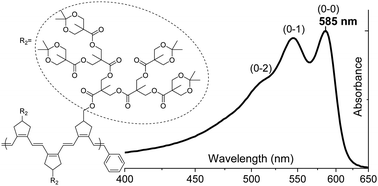Spectroscopy and excited state dynamics of nearly infinite polyenes
Abstract
Steady-state and transient absorption spectra with <50 fs time resolution were obtained for two conjugated polymers, both with ≈200 conjugated double bonds (N), constrained in planar, stable, polyene frameworks. Solutions of the polymers exhibit the same S2 → S1 → S* → S0 decay pathway observed for the N = 11–19 polyene oligomers and for zeaxanthin homologues with N = 11–23. Comparisons with the excited state dynamics of polydiactylene and a much longer, more disordered polyene polymer (poly(DEDPM)) show that the S2, S1, and S* lifetimes of the four polymers are almost identical. The S* signals in the polymers are assigned to absorption from vibrationally excited ground states. In spite of significant heterogeneities and variations in conjugation lengths in these long polyenes, their S0 → S2 absorptions are vibronically-resolved in room temperature solutions with electronic origins at ≈600 nm. The limiting wavelength for the S0 → S2 transitions is consistent with the persistence of bond length alternation in the electronic ground states and a HOMO–LUMO band gap in polyenes with N ≈ 200. The coincidence of the well-resolved S0 → S2 electronic origins and the convergence of the excited state lifetimes in the four polymers point to a common, “nearly infinite” polyene limit.

- This article is part of the themed collection: 2020 PCCP HOT Articles


 Please wait while we load your content...
Please wait while we load your content...